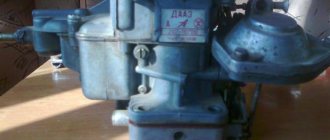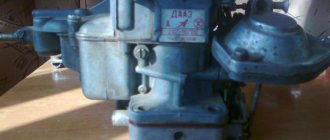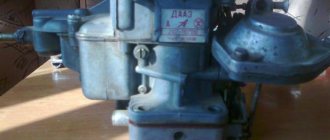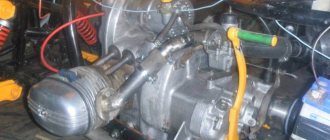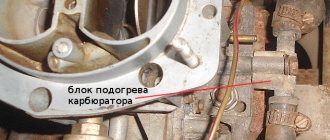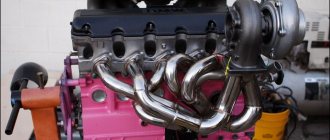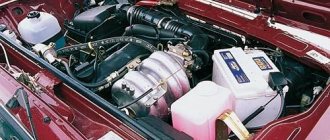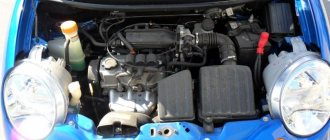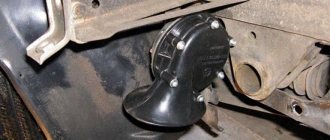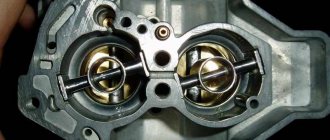When experienced motorists casually throw out the phrase “before, technology was extremely reliable,” they are, in a certain sense, right. Indeed, is it worth comparing the level of complexity of a modern car and its analogue from 50-60 years ago? And if the product is simple, then by definition it is more reliable. Owners of cars of the latest generations will certainly agree with this: if major breakdowns at the initial stage of operation are very rare, then you only need to have time to deal with minor faults.
In this aspect, the products of the Leningrad Carburetor Plant can be considered legendary, and its flagship is rightfully recognized as the K-151 carburetor, better known under the pseudonym Pekar. Its reliability is legendary; it is no coincidence that it is used on vehicles with ZMZ and UZAM power units, in particular on the famous domestic UAZ SUV. But, as you know, this device demonstrates the greatest efficiency with the correct settings. Today we will tell you how to achieve this.
Functions and design of the carburetor
In modern engines, an electronic system working in tandem with an injector is responsible for preparing fuel assemblies. The predecessor of this circuit is a carburetor, which is able to prepare a high-quality combustible mixture without any participation of electronic brains. And since the proportions of the mixture change depending on the operating mode of the engine, the carburetor must be able to prepare the optimal composition under any load, from idle to maximum crankshaft speed. And, I must say, he copes with this task well. Even today, K-151 can be found on such domestic cars as the Gazelle with all its modifications, IZH, Volga, and, of course, UAZ.
Although there are many models in the assortment of the Pekar brand, the “one hundred and fifty-first” is given pride of place, and there are many modifications of this carburetor, differing in the name by the letter after the numerical designation of the model. In particular, GAZ-3302 (or simply “Gazelle”), as well as GAZ-3102 (“Volga”) cars are equipped with a K-151S modification carburetor. The differences between the modifications consist of jets of different diameters, designed to prepare fuel assemblies for specific power units.
Composition of the Pekar-151 carburetor:
- body with a float chamber;
- a secondary upper housing in which throttle valves are installed, controlled by a drive cable connected to the accelerator pedal;
- PC cover, which serves as a platform for installing a locking mechanism that prevents the chamber from overflowing with fuel. An air damper is also located here, used when starting and warming up a cold engine;
- a dosing system, which is responsible for the formation of the air-fuel mixture and includes channels of a certain diameter, two air and the same number of fuel nozzles;
- idle subsystem used when the power unit operates in idle speed mode. Includes a bypass channel, one fuel and air nozzle each, screws for adjusting the quantity/quality of the combustible mixture, a membrane-type economizer valve;
- accelerator pump, responsible for uniform engine dynamics, without failures with a sharp increase in speed. Includes additional channels passing through the housing with a float chamber, a membrane device, a ball valve and a gasoline sprayer;
- econostat is a part that enriches the mixture when the engine operates at high speeds. Includes a system of additional channels designed to supply an unscheduled portion of fuel to the intake manifold with the throttle valves fully open;
- a transition system, which is activated at the initial stage of opening the remote control, located in the secondary chamber and serves for a smooth increase in speed. Includes a pair of jets of both types.
Thus, the K-151 belongs to the category of two-chamber carburetors, in which the throttle body opens sequentially. A strainer is integrated into the inlet fitting. It also has a fuel line designed to drain excess gasoline back into the tank and to protect against excess pressure in the chamber. As you can see, this device cannot be called simple, so setting it up requires considerable experience.
Why does the car jerk?
The jerking of the vehicle is similar to shaking, and is mainly caused by an incorrect air-fuel mixture formation system. So, first of all, this can be caused by low-quality gasoline. It is worth checking how well the fuel is burned in the cylinders. To do this, it is best to unscrew and inspect the condition of the spark plugs. It is also recommended to check the spark generation and air supply systems.
Often, experienced car enthusiasts, if the car twitches, recommend unscrewing the idle speed control and revving it up.
As practice shows, black smoke will come out of the exhaust pipe - this is not burnt fuel. Then, if the car twitched and stopped after the procedure, it means that the combustible mixture does not burn completely.
Connecting hoses
The complex structure of the K-151 is also evident when it is connected to the engine. It provides for the use of a whole range of hoses, but only two different sizes are used, so it is quite possible to confuse them, and the motor will malfunction in certain modes. The order of connecting the hoses to the carburetor:
- Fuel is supplied through the fuel pipe to a fitting located under the float chamber on the engine side;
- the return hose is put on the lower fitting - it looks in the direction opposite from the power unit and is located below the inlet;
- two small cross-section hoses are connected to the solenoid valve, the other end of one of them is connected to the economizer valve;
- the second end of the thin hose is put on the fitting located in the lower part of the K-151 on the back side of the DZ body (there are two of them standing next to each other, we use the lower one);
- onto the upper fitting of this pair we pull the hose that goes to the vacuum ignition advancer (it is located on the distributor);
- a large diameter fitting on the DZ housing is used to connect the forced crankcase ventilation pipe, a device usually located on the valve cover;
- a small diameter fitting located in the middle part of the K-151 is used to connect a thermal vacuum switch, however, this pipe is used only if the engine has an exhaust gas recirculation system. If such a system is not provided for a particular modification of the motor, a plug is simply installed on this fitting. True, such a precaution is unnecessary - there is no air leak through this fitting.
If you lack experience, these connections should be made by consulting the instructions for the device.
Connecting carburetor hoses K-151D
Adjustment of XX on Pekar
Adjusting the idle speed on the St. Petersburg K-151 carburetor is of fundamental importance. This is a special mode of engine operation that requires stable operation. This is exactly what is achieved by correctly configuring the idle, which also helps to minimize the amount of carbon dioxide in the car’s exhaust, which is important from the point of view of modern environmental requirements.
Over time, as a result of clogging of the filter mesh, the amount of fuel burned in the XX mode increases beyond the norm, and in this case the situation can be corrected by appropriate adjustment.
This operation is not particularly difficult:
- First you need to warm up the CA to operating temperature;
- then you need to find the fuel assembly quality screw located on the rotation shank and remove the limiter from it. Please note that the rotation limitation function is not present on all Pekar modifications. If your car does not have it, just proceed to the next step;
- We adjust the quality screw, for which we look for the position of the screw at which the power unit will produce the maximum number of revolutions when operating at idle. This point should be determined by ear (more accurate methods require the use of special equipment);
- Now we move on to the quantity screw located nearby, by adjusting which you should increase the crankshaft rotation speed by 100-120 rpm. After this, you need to completely tighten the quality screw, which will lead to a drop in speed by the same amount (within 100-120 rpm).
If, when turning the quality screw back, the speed does not drop as a result of a slight leaning of the mixture, then this indicates the presence of carburetor malfunctions.
Results
In the end, if you yourself are not a great carburetor specialist, then the easiest way is to turn to the craftsmen who live at the service station for help. There, for a certain amount of money, they will change everything for you and check how the system works. Although, of course, there is no 100% trust in the masters either. There were cases when, during installation, the difference in the structure of the native and VAZ EPHH block - forced idle - was ignored. As a result, the engine operated at idle with interruptions and flaws when driving.
You should try to avoid such nuances and properly set up the newly installed unit right away, so as not to mess around with breakdowns in the middle of the road. And then the question of which carburetor to install on the 402 Volga engine will be resolved by itself. From experience: as a result of a journey of 850 km, the GAZ-24 consumed only 80 liters of gasoline, that is, less than 10 per hundred!
Solex carburetor for the ZMZ-402.10 engine: does it make sense?
I’ll say right away that everything stated below is my purely personal opinion, compiled on the basis of studying the literature (in particular, the books “Carburetors of Passenger Cars. Design and Operation.” M.: Transport, 2000 and “Systems and Processes of Fuel Supply of Internal Combustion Engines” St. Petersburg: Publishing house of St. Petersburg State Technical University, 1999)
I’m not going to argue with anyone about this, I just want to present the arguments that personally guided me when choosing a carburetor.
1. What are “Volgov” Solexes?
Let's start with the fact that the Dmitrovgrad Automobile Aggregate Plant (DAAZ) does not produce Solexes for ZMZ engines. The only carburetor produced by the plant for 2.5 liter engines is DAAZ-4178. It is intended for UAZ UMZ-417 engines, although it is planned to produce a “Volgov” version for the 402nd engine - DAAZ, but so far no one has seen it on sale.
Some time ago, DAAZ produced DAAZ-2410 carburetors, but these were small-scale units, no more than 100 units per month, and their production has now been discontinued.
The same carburetors that are offered in stores under the guise of DAAZ-3110, DAAZ-31029, DAAZ-2410 and others like them are nothing more than other models converted in artisanal conditions to fit the “Volgov” air filter and throttle valve drive. It is not difficult to find out exactly what a particular carburetor is made of - there is always a casting on the body with the model number. As a rule, this is a DAAZ-21073 carburetor for the Niva VAZ-21213 with a 1.7-liter engine, although I also came across copies converted from DAAZ-21412 (for M-21412 with a 1.5-liter UZAM-331 engine).
2. Carburetor geometry
By “geometry” in this case we mean the configuration of the large carburetor diffusers, which affects, firstly, the intake flow resistance (limiting the maximum air flow through the carburetor), and, secondly, the inlet flow rate and vacuum in the small diffusers (affecting , in turn, on the composition of the mixture).
In this case, we can consider the engine as a piston pump of a certain performance (depending on the cylinder diameter, piston stroke and crankshaft rotation speed), at the inlet of which a throttle washer (large carburetor diffuser) is installed. From the equality of air flow through the diffuser and pump performance (assuming continuity of flow, of course), the following formula is obtained for calculating the required diameter of a large diffuser:
Adjusting the PU carburetor K-151
The starting device is a unit that is the source of the signal informing about the start of the power unit. If the elements of the starting system are faulty or do not work correctly, you will not be able to start the car. But even with a working starting mechanism, problems are possible that make starting difficult. To correct them, the K-151 carburetor is adjusted, and such work can be carried out both on a dismantled and on a working device installed on the engine.
Adjustment on a dismantled Pekar is carried out in the following order:
- open the remote control slightly and look for the control lever;
- turn it to its extreme position and fix it with something suitable (rope, wire);
- release the remote control to its original position. In this case, the gap between the chamber wall and the edge of the damper should be within 1.5±0.3 mm;
- unscrew the locknut that blocks the rotation of the stop screw located on the remote control lever;
- We turn the screw itself in stages, half a turn each time. At the same time, we must ensure that when tightening the locknut, the screw is located perpendicular to the cam, otherwise the control unit will not work;
- We check the thrust valley, with the help of which the PU cam is connected to the air damper levers. With the PU lever turned to its extreme position and the air intake completely closed, it is necessary to achieve a gap between the levers within 0.2-0.8 millimeters. If this is not the case, adjustment is made by releasing or tightening the rod head, which allows the rod itself to be shortened or lengthened.
Specifications
Before you begin to consider malfunctions and methods for eliminating them, it is worth understanding what technical characteristics the power unit has. To consider this issue, you should refer to the technical documentation of the manufacturer.
| Name | Characteristic |
| Manufacturer | ZMZ |
| Model | ZMZ 24, ZMZ 24D |
| Modifications | ZMZ 4021, ZMZ 4022, ZMZ 4025, ZMZ 24S |
| Motor type | Petrol |
| Injection type | Carburetor |
| Configuration | 4-cylinder in-line longitudinal internal combustion engine |
| Engine power | 95 hp |
| Number of cylinders | 4 |
| Number of valves | 8 |
| Piston diameter | 92 mm |
| Piston stroke | 92 mm |
| Cooling | Liquid |
| Block and head material | Aluminum |
| Resource | 300,000 km |
| Cylinder operating order | 1-2-4-3 |
| Ignition system | Contact or non-contact |
The GAZ 3110 car with a 402 carburetor engine was equipped with a 4 and 5 speed manual transmission. Thus, the power unit has a lower camshaft, a closed liquid cooling system and a dry clutch.
The most difficult factor for all car enthusiasts was that the engine has significantly high fuel consumption. So, gas 3110 engine 402 carburetor has fuel consumption:
- The gasoline version of the power unit “eats” about 13 liters in the city. On the highway, things are a little simpler; here you can achieve 10 liters per hundred square meters. If you install a “Zhiguli” carburetor instead of the original one, you can reduce consumption by about 10%.
- As for vehicles operating on gas, in this case, the consumption on the highway will be about 10-12 liters of gas, and in the city the figure will increase to 13-14 liters.
Adjusting the fuel level in the float chamber
An incorrectly set gasoline level in the PC is an imbalance in engine operation. If it is too high, the mixture will be enriched, and one of the most noticeable consequences of this state of affairs will be increased fuel consumption. At a level below the norm, the fuel assembly will be lean, which is even worse for the engine, since it can lead to serious damage requiring expensive repairs.
Thus, the fuel level in the float valve is a critical indicator for any carburetor, regardless of the brand and model.
To accurately adjust the float in the K-151 chamber, we will need a ruler and a drill with a diameter of up to 2 mm.
Float chamber of carburetor K-151
- we install the machine on a flat horizontal platform (this is important since we will be working with liquid);
- dismantle the air filter housing located on the power unit;
- we start the engine, let it run at XX for about 5-7 minutes;
- unscrew and remove the top carburetor cover;
- measure the fuel level in the float chamber in millimeters. This operation should be carried out promptly, since gasoline is characterized by a high volatility rate, especially in the heat, which will also be facilitated by engine heating. By delaying, we risk getting distorted results;
- for K-151, measurements should give about 215 millimeters - this is an indicator considered normal for efficient engine operation;
- if the level does not correspond to the standard level, we perform an adjustment, which consists of changing the position of the float;
- To do this, we need to use something that allows us to measure the position of the float during adjustment work - the drill suggested at the very beginning, or a piece of wire, or any similar cylindrical object will come in handy. The main thing is that its diameter does not exceed two millimeters;
- turn the K-151 cover over and place it on a flat horizontal surface - only in this position will the measurements be accurate;
- Using a ruler, measure the distance from the carburetor cover (choose a cardboard gasket as a reference point) to the lower edge of the float. This distance should be no more than two mm;
- if this is not the case, you should bend the tongue of the float lever in such a way as to achieve the standard clearance.
The same operation can be performed using a caliper, but in this case you need to measure the distance from the cardboard spacer to the top edge of the float. The correct result is 30 millimeters. If there is a discrepancy, we again bend the lever tongue, achieving the required value.
Removing the K-151S carburetor cover
Please note that when making all the settings described above, there is a possibility of errors, especially if this is done by an inexperienced car owner. Therefore, after making the adjustment, you must check its correctness. This is done like this:
- move the K-151 cover to a vertical position;
- we monitor the tongue that we bent (or did not touch if the level was normal);
- If everything is done without errors, the tongue should lightly press and press the damping ball located on the IR. In this case, the lever tongue should be located at a level running strictly parallel to the needle valve;
- We also look at the float stamping axis, which should be located at a level coinciding with the carburetor cover.
If at least one of these conditions is not met, the procedure for adjusting the fuel level in the PC will have to be repeated. Many drivers limit themselves to two iterations, even if the situation requires otherwise. We recommend that you complete the setup properly, regardless of the time spent - the experience gained will definitely be useful to us!
Fuel consumption directly depends on the condition of the fuel system, and if there are faults in it, the car's dynamics also deteriorate and the engine begins to operate unstably.
This article will discuss the K151 carburetor: design, repair, adjustment, configuration features, as well as the main problems and their symptoms.
K-151 carburetor design
In the fuel system, the carburetor of the K-151 model performs the function of preparing the air-fuel mixture in the composition necessary for the operation of a car engine under various loads - at idle, at medium or maximum speed. This unit is used on Volga and IZh passenger cars, Gazelle and Sobol commercial vehicles, and UAZ SUVs. There are various modifications of the “one hundred and fifty-first”, and depending on its model, a letter is added to the name at the end, for example, the GAZ-3102/31029, GAZ-3302 “Gazelle” cars are equipped with the K-151S carburetor. Also, depending on the K-151 model, jets can be installed with different sections - much depends on the characteristics and size of the engine.
The 151 series carburetor consists of the following systems and elements:
- main body (middle part) with a float chamber;
- throttle body – the valves rotate due to the drive connected to the accelerator (gas) pedal;
- the top cover of the float chamber - it contains a locking mechanism that prevents the chamber from overfilling with gasoline, as well as an air damper necessary for starting a cold engine and warming it up;
- main dosing system - is the main one in the preparation of the air-fuel mixture (FA), consists of channels of a certain cross-section, two fuel and two air jets;
- idle system, which is necessary for stable operation of the internal combustion engine at idle speed - it includes a bypass channel, adjusting screws (quality and quantity of fuel assemblies), jets (fuel and air), an economizer valve with a membrane mechanism;
- accelerator pump - it allows the car to drive without failures during sudden acceleration, consists of additional channels in the main body, a ball valve, a diaphragm mechanism and a fuel sprayer;
- econostat - the system is designed to enrich fuel assemblies at high engine speeds; it represents additional channels through which, under the influence of high vacuum when the throttle valves are open, an additional portion of fuel enters the intake manifold;
- transition system - it is needed for a smooth increase in speed at the moment the throttle valve begins to open in the secondary chamber; it consists of fuel and air jets.
The K-151 carburetor consists of two chambers, the throttle valves in it open sequentially, and a filter - a protective mesh - is installed at the inlet of the fitting. The unit is also equipped with a return fuel line, through which excess gasoline is discharged back into the gas tank, and the “return” does not allow the creation of excess fuel pressure. The design of the K-151 carburetor itself is quite complex, and in order to repair and adjust the unit, you need experience and strict adherence to the repair instructions.
Compatibility
But what about such an important indicator as compatibility, you ask? Almost all carburetors (two-chamber), both domestic and many foreign, can be interchangeable and coincide in many of their parameters and connection sizes. DAAZ-2107) can also function successfully on the Volga
), and gas (
K-151
and
156
), and azlkash. There will, of course, be a difference in performance, and the diameter of the jets will need to be adjusted. So, the VAZ unit has a smaller diffuser.
When installing something like this on a Volga (or UAZ), it will provide excellent gas savings, but will reduce the engine's agility and throttle response - you won't be able to drive it much anymore. 21083
– more accurately produces dosage in different modes. So, we draw conclusions: if there is a very big need for savings, then we install DAAZ, and if we want to get a more powerful car, then K-151.
Connecting hoses to the carburetor
Several hoses of two diameters are connected to the K-151 carburetor - if they are mixed up, the engine will not work properly. We connect the hoses in the following order:
- the main fuel pipe - to the fitting, which is located under the float chamber closer to the engine (in the picture it is held in the hand);
- “return” - to the lower outlet (it is directed on the opposite side of the engine, and is located below the main fitting);
- two thin hoses go from the solenoid valve, one of them goes to the XX economizer valve;
Conclusion
The ZMZ 402 engine for the Volga 3110 has a high fuel consumption rate compared to modern cars. The owner will have to fill 13 liters for every 100 km for urban operation and 10-11 for suburban use. The main malfunctions are tripping and jerking. This means that the fuel in the power unit is not completely burned or the formation of the air-fuel mixture is disrupted.
The K-151 model carburetor was installed on Gazelle 2705, GAZ 3102, 3110 cars with ZMZ 402 power plants. The device consists of elements responsible for getting the combustible mixture to the cylinders. The carburetor model K 151 is used as a standard device; there are varieties 151 “C” and “D”, differing in some parameters. Before you understand which carburetor is better to install on a UAZ with a 402 engine, you need to study the parameters and design of the unit.
Adjustment
If without experience it is quite difficult for car owners to repair the K-151 unit with their own hands, then it is easier to master the adjustment, the main thing is to understand the principle of operation of the device and act according to the instructions. There are several types of “one hundred and fifty-first” adjustments:
- idle move;
- air damper position;
- gasoline level in the float chamber;
- throttle position.
Changing the fuel level in the float chamber should be trusted to experienced carburetor specialists, but any driver can adjust the idle speed independently. We carry out the procedure as follows:
- warm up the engine to operating condition;
- leave the engine running at idle speed, the air damper should be completely open (the choke is recessed);
- turn out the quantity (with spring) and quality screws, allow the motor to reach maximum speed;
- gradually tighten both screws until the internal combustion engine begins to operate intermittently;
- Use the quantity screw to slightly increase the speed, while adjusting the quality to “catch” the stable operation of the motor, but this screw should be tightened as much as possible. It should be taken into account that the position of the quality screw significantly affects fuel consumption, so it is turned as much as possible;
- We tighten the quantity screw a little, achieving stable engine operation at 700-800 rpm. If you tighten the “quantitative” screw too much, failures begin at the moment you sharply press the accelerator pedal. We must also not forget that the stability of the internal combustion engine depends to a large extent on the ignition control.
If the engine speed is high, you should reduce it using the screw that adjusts the position of the throttle valves. This screw often boils tightly, and it is impossible to turn it in any direction (in the picture below, under the number 4, under the white paint).
There is one “tricky” way to force the adjusting element to turn - you need to install a flat-head screwdriver in its slot and carefully hit it several times with a hammer (you need to feel the force, otherwise you can break parts of the carburetor). The screw will “come away” and begin to rotate on the thread. If the “trick” does not work the first time, it should be repeated. It is important to take your time and be patient, then everything will work out.
Repair
During the operation of the car, various malfunctions may occur in the carburetor; the main signs of malfunctions in this device are:
- increased fuel consumption;
- black smoke from the muffler pipe, it is especially noticeable if you press the gas pedal sharply;
- unstable operation at idle, the engine may also stall when the speed is reduced;
- poor car dynamics;
- failures when accelerating.
If the carburetor is faulty, the engine may not develop speed, and popping noises and shots from the muffler are often heard in the intake manifold. K-151 is a rather complex unit, and almost any element of it can fail.
There are reasons why a carburetor most often fails:
- jets, fuel and air channels become clogged;
- heating causes deformation of the body;
- the float chamber shut-off valve stops working;
- Over time, the jets wear out.
Many repairmen, when restoring the functionality of the carburetor, first of all try to replace the jets, believing that because of them, fuel consumption increases and the engine runs unstable. One rather important note - the jets wear out very rarely, and most often wear occurs when the carburetor is often operated in dusty conditions. The most common reason for poor carburetor performance is its clogging, but in order to thoroughly clean the unit, it is necessary to completely disassemble it. Repair of the K-151 carburetor is carried out with the removal of the device, complete washing and purging of all its parts.
Setting goals
Of course, fuel consumption can depend on many things: even on the pressure in the wheels, high-quality or counterfeit oil poured into the engine compartment, and the serviceability of the engine itself. But the carburetor still has the most important impact on the data.
First of all, it (as well as its correct adjustment) will largely determine how voracious the machine’s appetite will be. And if you set yourself the task of reducing gasoline consumption, then changing the carburetor to a more advanced model will help you achieve it.
Problems with the carburetor when installing gas equipment
Often, car owners switch cars with carburetor engines to gas; for example, it is profitable to install LPG on a working Gazelle. But with the constant use of gas in the carburetor, various types of problems appear, and one of them is a malfunction of the cold start system on the carburetor.
On many cars, the gas system uses a gas spacer for the K-151 carburetor; it is placed between the main body and the throttle body. Due to the additional insert, the distance between the lower and upper parts of the carburetor increases, so the cold engine starting system begins to work irregularly - you have to constantly keep your foot on the gas pedal, while holding the choke. On gas, a choke that is not fully working does not affect the operation of the engine, but the whole point is that cold starts of the engine, and especially in winter, are carried out on gasoline. Therefore, it is quite problematic to start the internal combustion engine with the air damper not completely closing; even due to the resulting vibrations, the fastening of the damper axis is often unscrewed. How to get rid of such an unpleasant problem?
One of the options for solving the problem is to weld an additional strip onto the air damper rod, which allows you to compensate for the difference in the thickness of the standard gasket between the housings and the gas spacer.
The bar can be made from an electrode with a diameter of 2 mm.
Compatibility of this engine model with other carburetors
In terms of design features and scope of application, carburetor devices are not very different. According to some car enthusiasts, almost all types of carburetors are installed on Gazelles and Volgas; in order to decide which carburetor to install on the 402 engine, you need to know the list of suitable ones in design. DAAZ models from 2107 VAZ models, as well as some modifications from AZLK and ZMZ cars, are no exception.
It is important to note that it is possible to increase the efficiency of gasoline, but this will require significant financial and time costs. Installing a less powerful modification will not allow the full power of the engine to be realized, and consumption may remain at the same level.
Replacing the K-151 carburetor
If the parts are severely worn, the carburetor needs to be replaced; most often it is changed if the housing wears out:
- the lower surface of the middle part is severely deformed;
- the cover (upper part of the body) is warped;
- The seat for the throttle valves in the lower part wears out.
The price of a new K-151 carburetor is quite high (on average 5.5-6.5 thousand rubles), but it is impossible to drive with a faulty device, especially since with high fuel consumption even more money is lost. Changing the K-151 is quite simple; let’s look at the process of replacing it on a Gazelle car:
- turn off the engine, unscrew the air pipe clamp, dismantle the “corrugation”;
- dismantle the air filter housing - first the cover, then the main body (secured with three 10mm nuts);
- loosen the two fastenings of the choke cable, pull out the cable;
- disconnect the throttle cable;
- free the carburetor from all hoses;
- unscrew the 4 nuts that hold the device body;
- dismantle the unit - it can fit very tightly, so you can slightly pry it from below with a screwdriver, but you need to work with the tool carefully so as not to damage the gasket under the carburetor;
- We put the new carburetor in place, start and warm up the internal combustion engine, and adjust the idle speed.
Advantages and disadvantages of the K-151 model
The fuel distribution procedure established by the factory, when properly adjusted, can provide the vehicle with the necessary characteristics and moderate fuel consumption. The main advantages are the presence of an autonomous idle system, which allows you to regulate ignition and significantly save fuel under certain operating modes. A semi-automatic system for starting a cold unit helps the owner when starting the internal combustion engine in cold weather; it is possible to implement the start from the remote control.
On a gazelle engine 402, the carburetor is selected before asking the question of which carburetor to put on the 402 engine. It can be easily adjusted, is unpretentious in operation, and retains adjustments for a long time, unlike other models. It is necessary to carefully monitor the condition of fuel filters, carry out preventive maintenance in a timely manner, after which it is possible to achieve the set goals for fuel consumption.
The carburetor on the Volga 3110 with a 402 engine does not have many negative aspects, but they still cause some inconvenience. The design is not easy to disassemble and wash. Curved channels, a large number of levers, and springs present serious difficulties during maintenance. The locking needle is equipped with an elastic band, which also increases the service requirements.
Accelerator pump repair
If malfunctions occur in the carburetor accelerator pump, the engine begins to “choke” and failure occurs when the engine speed increases sharply. Quite often, the reason for such operation of the internal combustion engine is a clogged “nose” of the fuel nozzle; the accelerator pump diaphragm can also fail.
Diaphragm defects are determined by its external inspection; it can be easily reached without removing the carburetor from the engine. To do this, you need to unscrew the four screws of the cover (number 11 in the picture below), but you need to remove it carefully - it is important not to lose the spring, which is located inside the unit.
To determine the serviceability of the accelerator pump atomizer, you need to remove the air filter housing, turn the throttle valve by hand and see if fuel flows through the “spout” of the accelerator. If the nozzle is clogged, you can try to blow it out, but this will require removing the carburetor cover. If the spout does not blow through, it should be replaced; the work of replacing it is also carried out without removing the entire assembly. We replace the accelerator pump nozzle as follows:
- remove the air filter;
- disconnect the choke cable;
- unscrew the seven screws of the carburetor top cover;
- we take out the cotter pin of the trigger mechanism, release the rod, dismantle the cover;
- unscrew the nozzle screw, blow out or change the part;
Trouble the engine - what, why and how to deal with it
Troubleshooting means that the fuel injection mechanism into the cylinders is disrupted and the mixture does not ignite correctly. This effect is quite typical for gasoline engines. So, the primary reason why the engine stalls, both hot and cold, is the carburetor. This means that fuel injection is faulty.
Most likely, the needle does not hold and there is an overflow of fuel, which does not burn in the cylinders. To determine this malfunction, it is enough to either disassemble the carburetor, or unscrew and inspect the condition of the spark plugs.
Of course, when we touched on the issue of ignition, then if it’s not working, you should inspect whether there is any damage to this unit. So, you need to unscrew the spark plugs and check for a spark. Another node where a problem may arise is high-voltage wires, which can also fail.
The last place to look for a problem as to why the engine is misfiring is the air supply. So, it is worth inspecting the condition of the air filter. If it is clogged, it should be changed. The replacement interval set by the manufacturer is 20,000 km.
Replacing the needle valve in the float chamber
If the engine consumes a lot of fuel, one of the reasons for this phenomenon may be a faulty needle valve in the float chamber - it is not sealed, and too much gasoline enters the chamber. In some cases, the valve completely stops holding fuel, then the carburetor is completely filled with gasoline, and the car does not start. Changing the needle valve is very simple:
- remove the top carburetor cover;
- unscrew the screw that holds the float axis;
- dismantle the axle, remove the float to the side along with the needle itself;
- Using a 10mm wrench, unscrew the valve seat, then put new parts in place and assemble the carburetor.
Some features
Since probably only a few people dream of racing cars like the Volga, it would be advisable and practical to think about installing a Zhiguli carburetor on the 402 engine. In the old days, some happy owners of old Volgas, which absolutely shamelessly consumed gasoline that had become more expensive in the post-Soviet space, installed eight Zhiguli carburetors, and were very pleased with the results obtained. This was done exclusively for economic purposes, although some problems arose during installation (for example, with the length of the studs or the choke).
On Solex ( DAAZ-21083
) the holes are slightly offset (by a millimeter inward).
For final finishing, you also need to make a jet correction. Solexes already modified specifically for the Volga also appeared in the offer (labeling DAAZ-3110
). This greatly simplifies the task of a car driver planning to carry out reconstruction. You only need to choose the unit (the kit also includes an adapter for old air filters), and the rest is a matter of technique. To install a new one in place of the old one, you will need to spend very little time and physical effort.
Article on the topic: “How to set the fuel level in a Solex carburetor?”
